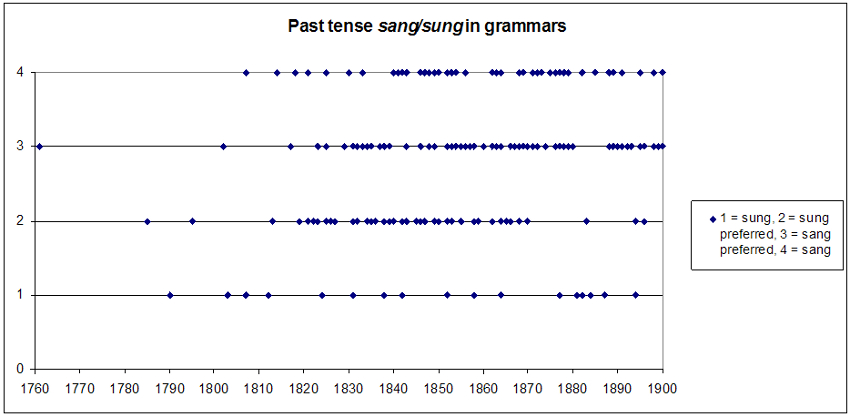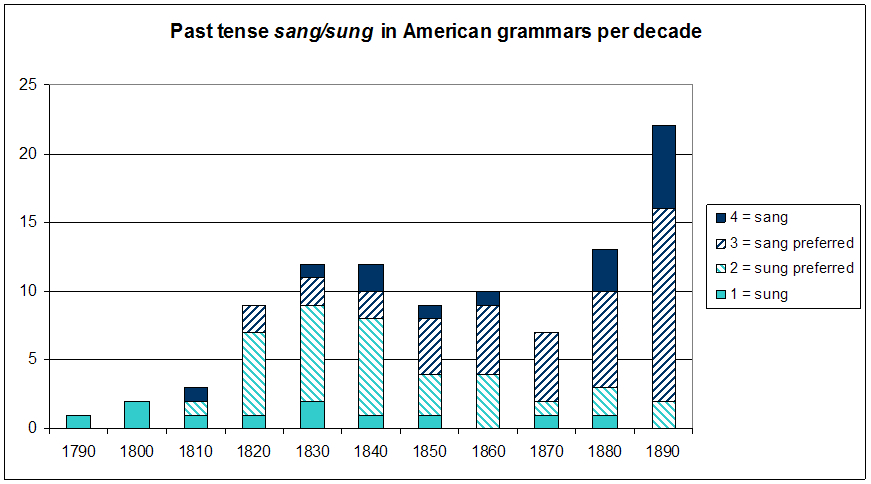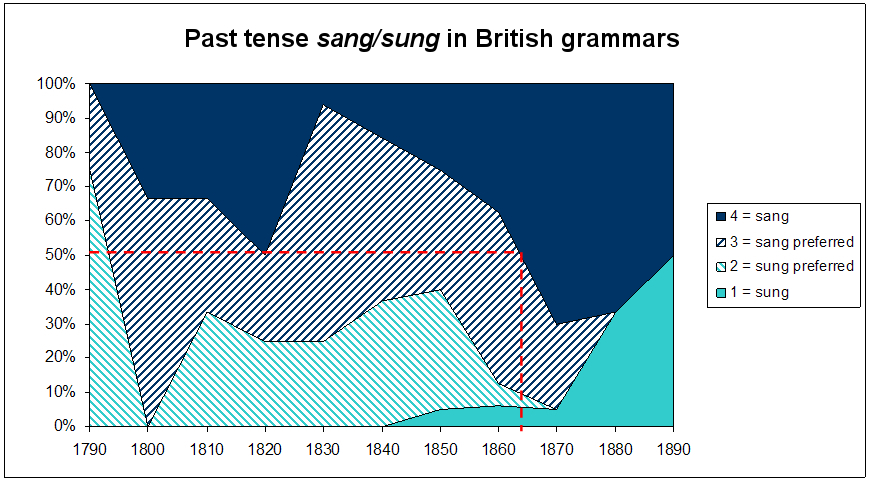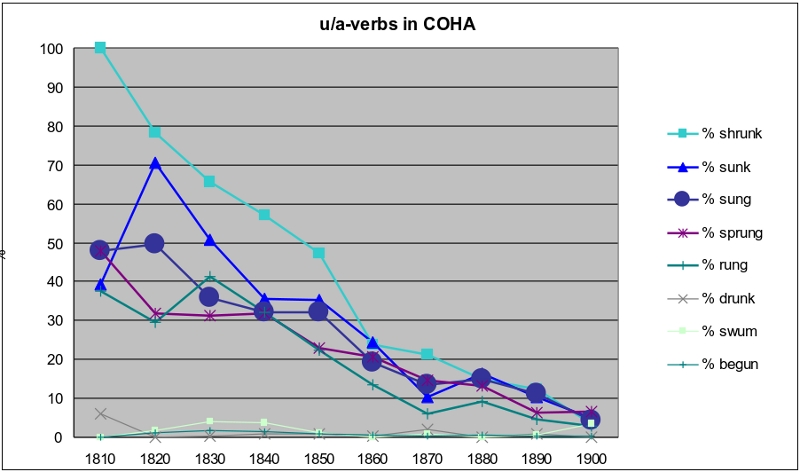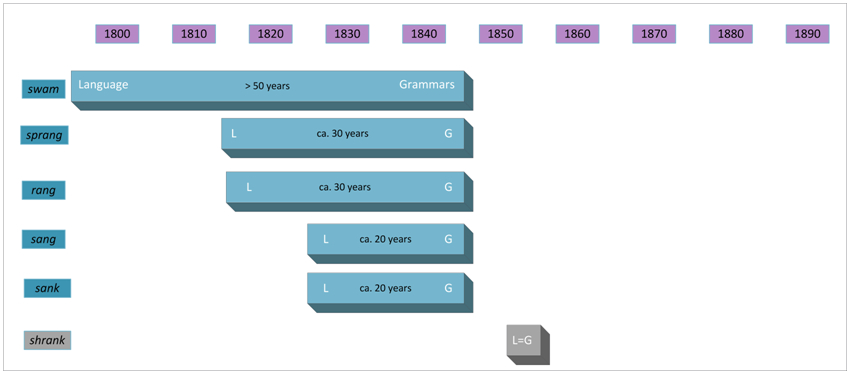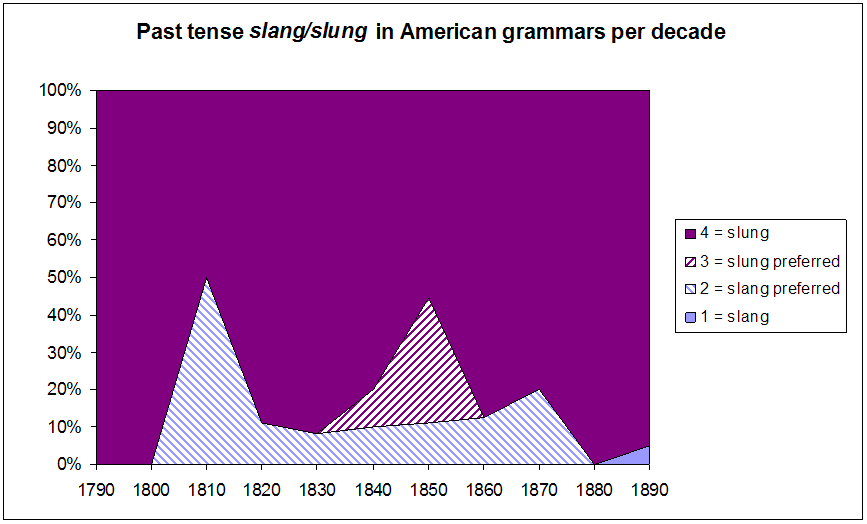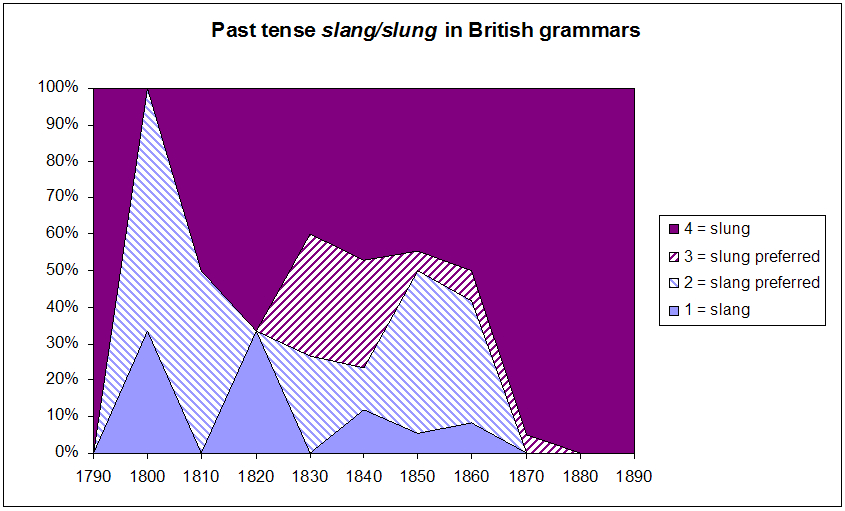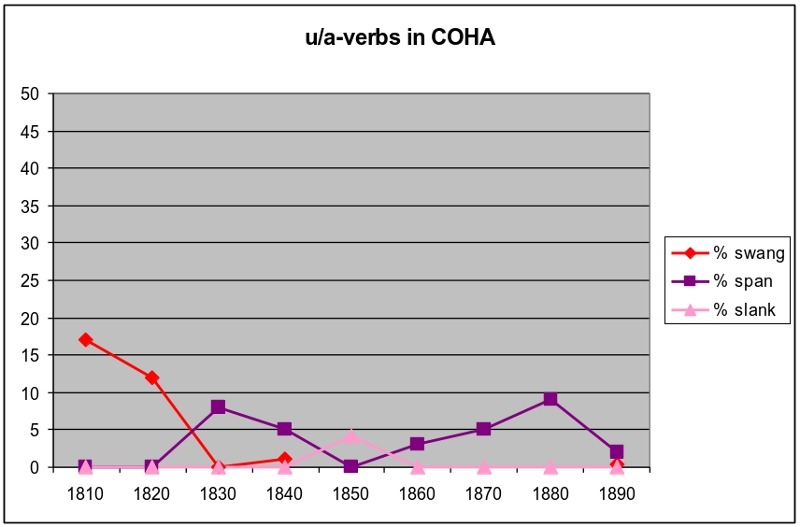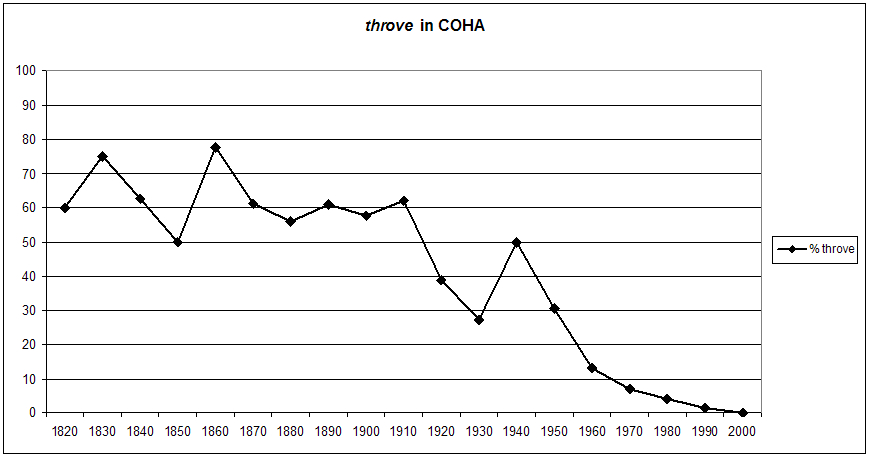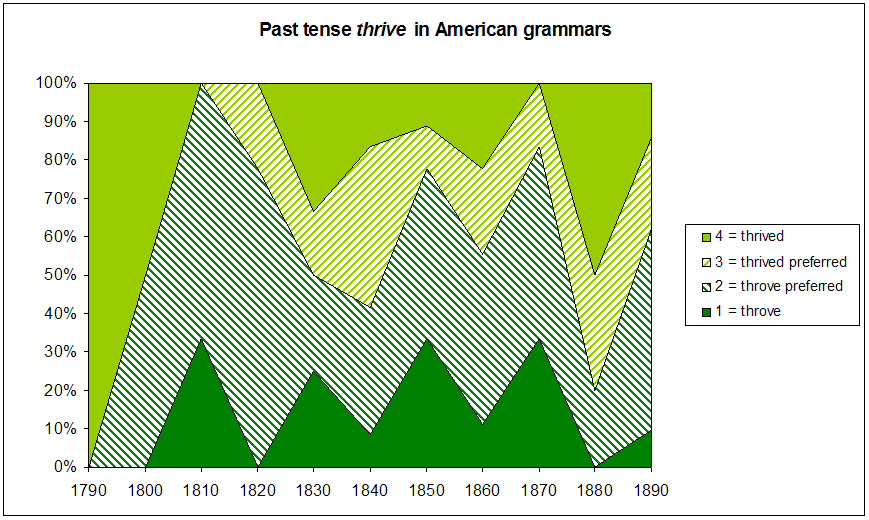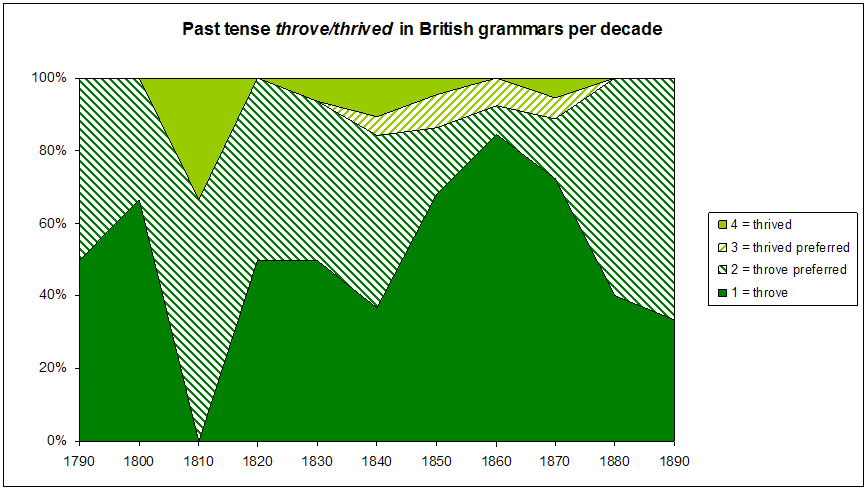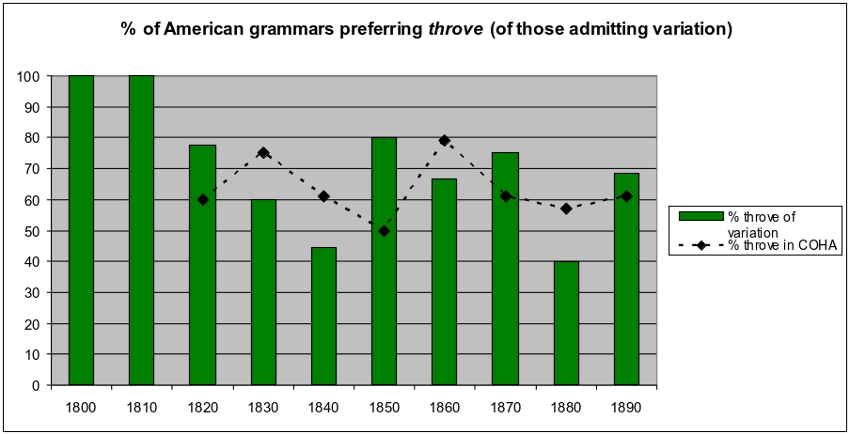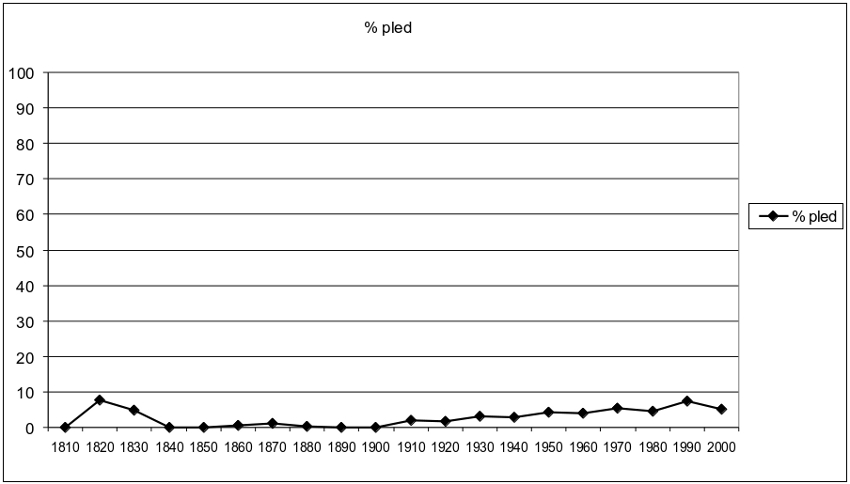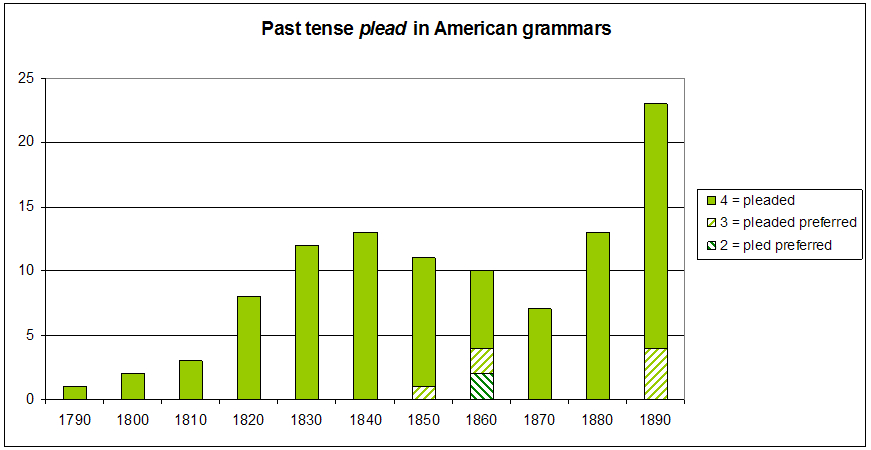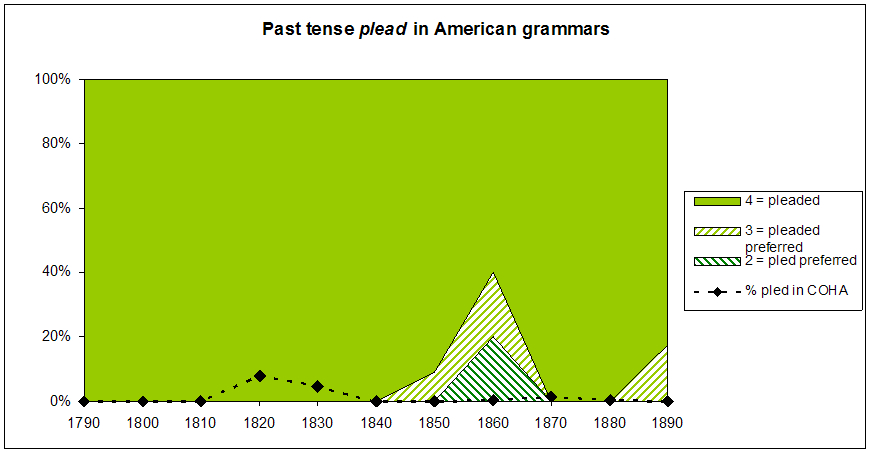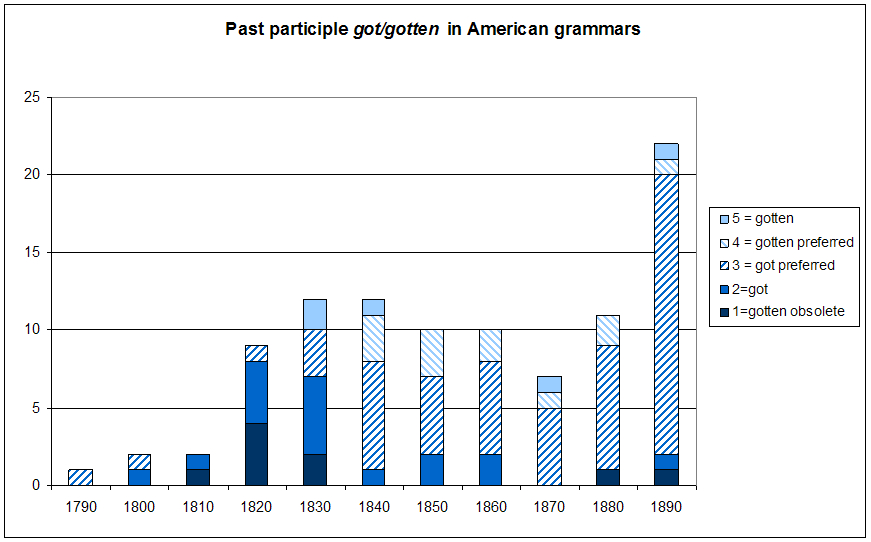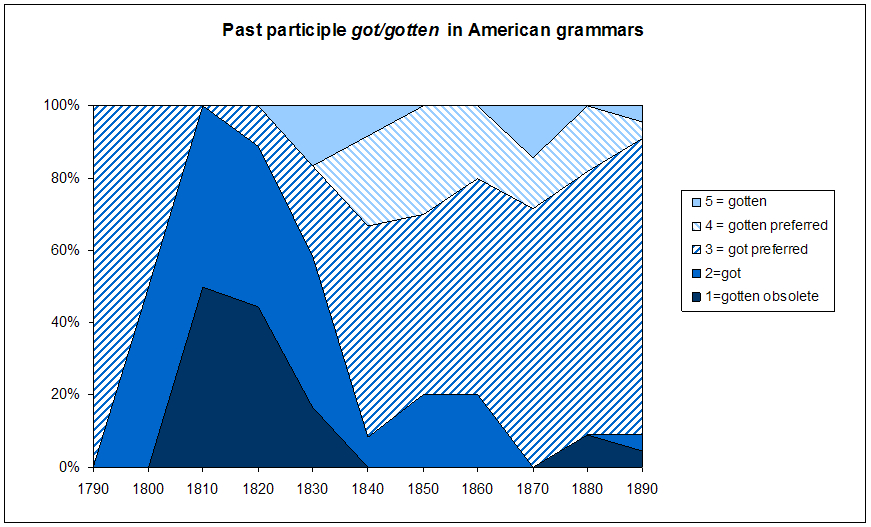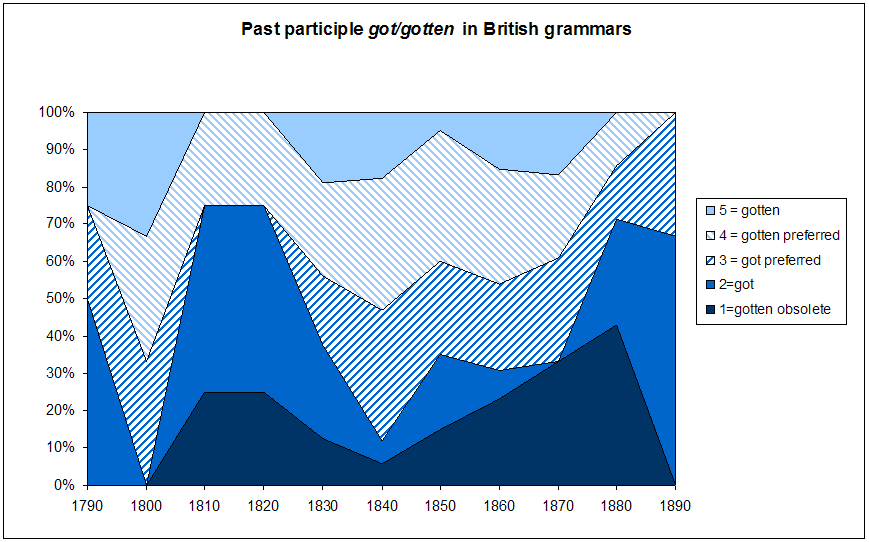Throve, pled, shrunk: The evolution of American English in the 19th century between language change and prescriptive norms
Lieselotte Anderwald
University of Kiel, Germany
Abstract
This paper investigates the evolution of some morphological differences between American and British English in the 19th century, and examines potential prescriptive influences on these developments. In particular, variable past tense forms in u/a-verbs (sing, shrink, drink) are compared to verbs in <u> (spin, sling) which show very little variation. This type of variation between different strong forms is compared to variation between strong and weak forms (in the verbs thrive and plead), and to the evolution of dynamic have gotten. In all cases, American grammars can be shown to differ strikingly from British grammars; however, evidence for direct prescriptive influence cannot be found. Instead, 19th century grammars (at least for the phenomenon of past tense verbs) seem to mirror, in most cases with considerable time lag, what was happening in the language of the time.
1. Introduction
In this paper, I will give an overview of (some) verbs that are clearly different in their past tense forms in American and British English today, and test with the help of my new resource the CNG what the origin of these differences are – in particular I want to test the hypothesis that prescriptive grammars had an influence on these different national developments. Rather than look at irregular(ly) devoiced verbs (burnt, smelt, spoilt), which have been studied to some degree (cf. Levin 2009 and references therein), I want to concentrate on a number of irregular verbs that have not commanded much attention to date: verbs around drink – drank – drunk, where variation is between different strong verb forms (past tense drank vs. past tense drunk), the two verbs thrive and plead, where an irregular form is in competition with the regular(ized) variant today, and the Americanism per se, the past participle gotten. In all cases, I compare corpus data from written American English over the course of the 19th century with a quantitative analysis of contemporaneous grammars. In this way, the data should begin to tell us whether grammars of the time mirrored language change, or whether they were actually instrumental in causing language change.
2. u/a-Verbs
My first case study is of a number of verb forms that I have studied in detail before, verbs like drink and sing, sling and swing (Anderwald 2009, 2007, 2011a); these verbs are what I will call u/a-verbs here. [1] Historically, these verbs belonged to one coherent verb class in Old English (usually called verb class III, cf. Krygier 1994), which was characterized by having two morphological past stems, one used for the singular, one for the plural. Simplifying somewhat, we can say that forms in <a> were used for the singular, forms in <u> for the plural forms as well as the past participle. In this way, ic, he sange was morphologically distinct from we, ye sungan, and from the past participle (ge)sungen. Today, the formerly homogeneous group of verbs is split between two kinds of paradigms: the slightly larger group has a past tense in <u> (sling – slung – slung) and thus has only two distinct forms overall, whereas the smaller group has a past tense in <a> (sing – sang – sung), resulting in a three-part paradigm. A complete list of verbs belonging in these two groups can be found in (1). [2]
| (1) |
a. cling, dig*, fling*, hang*, sling, slink, spin, stick*, sting, strike*, string*, swing, win, wring |
|
b. begin, drink, ring*, shrink, sing, sink, spring, stink, swim |
Since we know that especially in this second group of verbs, past tense forms are still variable in spoken language today (cf. Anderwald 2009), and that the strict division into two groups is a rather recent development in the written language (cf. also section 3.4. below), it makes sense to ask whether the (allegedly) prescriptive grammar writing of the 19th century was instrumental in any way in influencing these historical processes of language change.
3. The Grammars Study
3.1. The Collection of 19th Century Grammars (CNG)
For the purposes of this paper, 272 grammars of English published in the 19th century and slightly before were checked manually for lists of strong (or irregular) verb paradigms. (Terminology and definition vary over the course of the 19th century.) In most of them, our verbs were arranged alphabetically, as shown in Figure 1; in some cases, verbs were grouped according to their form explicitly, as in Figure 2, or (more rarely) implicitly, as in Figure 3. [3]
Of the 272 grammars investigated, 47 had to be excluded from this study completely, because they either listed no verbs at all, or only very few, or were incomplete in other ways – for example, in some cases, only the base forms were listed (e.g. [Anonymous] 1848: 53), obviously relying for the actual forms on pupils' (and teachers') implicit knowledge, and for this reason they were clearly not useful for the kind of study envisaged here. Altogether 18 verbs were checked in every grammar, covering different historical groups, not all of which will be reported here. The data were transferred to a spreadsheet program, where they underwent coding and calculations per verb. In all cases, the grammars' authors, their nationality, and the dates of actual and first publication (where known) were retained, so that these data could in a second step be correlated with the individual recommendations on each verb. [4] In this way, it becomes possible for the first time to trace changes in the community of grammar writers over time, in relatively fine temporal slices, over the course of the 19th century. [5] The procedure will be detailed in 3.2. with reference to just one of these verbs, the verb sing, and the results from the remaining verbs will be discussed in sections 3.3. and 3.5.
3.2. Past tense sing in the CNG
213 grammars in the CNG mention a past tense form of sing. 100 of these come from the US, 113 from the UK, so that a comparison across national boundaries looks promising. All past tense forms that are noted in the grammars are collected in (2), already ordered in the form of a scale:
| (2) |
sang |
4 |
|
sang or sung (obsolete) |
4 |
|
sang or sung (archaic) |
3 |
|
sang (preferable) or sung |
3 |
|
sang or sung |
3 |
|
sung or sang |
2 |
|
sung or sang (obsolete) |
1 |
|
sung |
1 |
The numerical coding employed for this study follows each variant in (2). The scale depicted is intended to be logical (illustrating possible intermediate steps from sung as the only form, through variation, to sang as the only form), as well as, roughly, historical (cf. Ekwall 1980). Thus, in all cases discussed here, the form represented by the highest number is the present-day standard English form. The scale for sing is made explicit in (3).
| (3) |
4 |
only sang is acknowledged (and recommended) |
|
3 |
variation is acknowledged: sang is preferred |
|
2 |
variation is acknowledged: sung is preferred |
|
1 |
only sung is acknowledged (and recommended) |
With this scale in mind, we can now categorize the recommendations in grammars. In a first step, all variants were correlated with the date of first publication, and (without distinguishing American from British sources) are depicted in the chart in Diagram 1.
As the uneven distribution of dots makes clear, the grammar books are not evenly spread over the century. This is both due to real-world differences in publication practices, and to skewed data: on the one hand, we know – at least for the British side – that the publication of grammars had distinctive peaks in the 19th century (cf. Michael 1997); on the other hand, some decades are over-represented in my material, possibly due to sampling biases in the Google Books project. To investigate national differences in more detail, and to neutralize possibly skewed materials, I have accumulated the data inherent in Diagram 1 above per decade. (cf. also Table 1 in the appendix.) In order to make different national trends visible, I have also separated American and British data.
Diagram 2 illustrates the absolute number of grammar books per decade that held one of the 4 opinions detailed above. In particular, solid colour indicates categorical judgements (navy: sang only, turquoise: sung only), whereas diagonal lines indicate the acknowledgement of variability. A preference of one of the forms is indicated by the direction of the slanting lines (upwards to sang, and downwards to sung).
Diagram 2 shows in absolute numbers that very many American grammars were in favour of variable forms – a large part of the individual bars is striped, rather than solid. In order to increase comparability across decades, the bar chart in Diagram 2 was converted into an areal chart of percentages, at the same time also allowing a comparative analysis with British grammars, despite differences in the absolute numbers of grammar books.
The areal chart makes it very clear that we are looking at the succession of at least three "waves" of recommendations (sung only > sung preferred > sang preferred). If we group all judgements coded 1 and 2 together, we can observe the complete ousting of the view that sing should have sung as the past tense form (either as a categorical view, or at least a preferential recommendation): the left part of the diagram is dominated by turquoise (solid and striped), and the right hand part of the diagram is dominated by the colour navy. The dividing line is almost perfectly diagonal, indicating continuous change over time. Also, this seems to be a genuine change of 19th century grammar writing: American grammars start out at the end of the 18th century and the beginning of the 19th proclaiming that sung is the only acceptable past tense form of sing, then begin to acknowledge variation, but prefer sung, then switch over and come to prefer sang, and finally (and only as a minority opinion) claim that sang is the only form possible. The switch-over point (from a preference of sung to a preference of sang) is just before 1850, as the dotted red line indicates.
The picture looks very different for the British grammars. Even at a first glance, much less of Diagram 5 is taken up by turquoise; the solid navy areas dominate much more than in Diagram 3 above (for absolute figures cf. Table 2 in the appendix). Even the striped turquoise areas (acknowledging variation, but favouring sung) are only ever a minority option in British grammars (perhaps with the exception of the very first decade under investigation here, covering the end of the 18th century; however, here only very few grammars are actually available, so that percentages are easily skewed).
In contrast to American grammars, for British grammars over the 19th century we see a continuing preference for sang, which gives way to a near-categorical recommendation of sang (the solid navy area). As the dotted red line indicates, this becomes the majority view in British grammars after 1860. In contrast, categorical advice to use only sang is never more than a minority opinion in American grammars, as we have seen above.
In terms of historical development, then, we can say that British grammars move only very slightly, from allowing variation to becoming more categorical, but recommending sang at all times, whereas American grammars seem to be more tolerant of variation, but switch more radically in their recommendations from favouring sung in the first half of the century, to favouring sang in the second half. In terms of our scale, we can say that American grammars as a whole move from a preference for sung, to a preference for sang, whereas British grammars move from a preference for sang to recommending sang only.
3.3. Extension to other verbs in this group
The analysis of sing above was extended to the other verbs in this group, in particular spring, swim, ring, and shrink. This was justified by the corpus study below: a verb like begin shows practically no variation in the corpus data, as Diagram 6 illustrates (cf. also Table 3 in the appendix), and since there is no development, we cannot expect prescriptive influence. A correlation with grammar pronouncements was therefore not deemed sensible for the larger part of the group of these verbs listed in (1) above that were not variable in the 19th century. Spring and swim, though marginally different in some details, show the same overall development as sing in the way they are treated in 19th century grammar books: American grammars change from preferring past tense forms in <u> to preferring forms in <a>, but allow and even actively promote variable forms. For spring and swim, British grammars also change over the course of the 19th century from preferring forms in <a>, to advocating forms in <a> only, again in a very similar way to sing. For ring, the situation is slightly different, but only in British grammars. Here we see a more extreme movement from a tolerance of variable forms at the beginning of the 19th century, to advocating <a> at the end.
The only form that is really very different is the verb shrink. We know from present-day sources that shrunk is sometimes connoted as an Americanism (Anderwald 2011b), and intuitively for many speakers, the title of the blockbuster film Honey, I Shrunk the Kids (Johnston 1989) has a distinctively American feel to it. (The British version would probably have been called something like Darling, I am terribly afraid I shrank the children.) For this reason, it would be interesting to investigate the treatment of shrink in 19th century grammars in some more detail. (Lack of space prevents me from doing so here, but cf. Anderwald submitted.) In sum, however, we can see a strikingly uniform treatment of this group of u/a-verbs in grammar books of the 19th century, moving from advocating forms in <u> to advocating forms in <a>, and with British grammars more advanced in this development than American ones.
3.4. Comparison with corpus data
In order to be able to gauge the influence of grammar writing on real language developments, the 400 million word Corpus of Historical American English COHA (Davies 2010–) was investigated for the verbs under discussion here. For this purpose, the individual verb forms were searched as strings coded as past tense forms, and the recall was checked in several samples. In order to find misclassified instances of the past tense, all forms in <u> classified as the past participle were also searched and manually checked. Forms that were clearly intended to represent non-standard speech were discarded; and the percentages of unambiguous past tense forms were then calculated manually per decade. The temporal development of the forms in <u> that were to become the minority forms over the course of the 19th century is depicted in Diagram 6 (for absolute figures cf. Table 3 in the appendix). In all cases, the missing percentages up to 100 are made up by past tense forms in <a> (e.g. shrank vs. shrunk, sprang vs. sprung etc.). Diagram 6 shows very clearly the decline of past tense forms in <u> in real time over the course of the 19th century. At the same time, it also shows that this development proceeded at different speeds and started from different beginning points, and also crossed the 50 percent line at different points, for the individual lexemes. Quite possibly, we might be looking at the process of lexical diffusion, where a morphological change proceeds through the language lexeme by lexeme. Although the direction of change is the same in all cases (towards fewer past tense forms in <u>), the trajectories of change clearly differ significantly.
Diagram 6 allows us to group these lexemes into three groups: drink, swim, and begin at the bottom of the diagram, where instances of past tense forms in <u> are far below 10% even at the beginning of the 19th century, with the 10%-point more or less arbitrarily defined as the point where an alternative can be said to become 'marginal' (but cf. Kretzschmar 2009); a second group of verbs that move from being variable at the beginning of the century to becoming fixed in <u> (sing, spring, and ring); and the two verbs shrink and sink that seem to undergo the most striking developments, from preferring past tense forms in <u> at the beginning of the century, to preferring past tense forms in <a> at the end. Based on these data, the lexemes have been ordered temporally in (4).
| (4) |
preferring past tense in <a>… |
|
since before 1800: drink, swim, begin |
|
|
|
after 1810: ring, spring |
|
after 1820: sing |
|
after 1830: sink |
|
|
|
after 1850: shrink |
Exemplarily, compare the switch-over point for sung with the recommendation in grammar books: although sung already moves below 50% after 1820 in written American English, the recommendation to use sang instead of sung only becomes the majority opinion in grammar books around 1850, as we have seen in section 3.1. – a time lag of over 20 years.
Diagram 7 gives the analogous temporal details for some of the other lexemes investigated here. For swim, the time lag between the change in language (as documented in COHA) and the change in American grammars (in the CNG) is even more striking, and amounts to more than 50 years. For sink, on the other hand, the time lag is smaller, for shrink both coincide.
This time lag is of course what we would expect in descriptive terms, given the general conservative character of grammar writing in the 19th century. [6] It is interesting to see that with the help of the CNG, we can for the first time quantify this descriptive lag; it is also interesting to note that, perhaps depending on the feature, the time lag is different for individual phenomena, and perhaps even individual lexemes. To a degree, u/a-verbs seem to have been treated by grammar writers as members of a class, as the cut-off point around 1840 shows which all lexemes (except shrink) share, irrespective of their actual development; lexeme-specific changes were clearly not accounted for by the majority of grammar writers. Judging from this evidence, grammars do not seem to have influenced what language users did, at least not across the board. For some of the lexemes under investigation here, they lag behind developments in actual language use by 20 to 50 years, or even more. Given that the grammars under investigation treated these verbs as a homogeneous group, actual prescriptive influence seems not very likely.
3.5. Extending the analysis to the complementary group of verbs
It is striking to compare the differentiated picture of verbs around sing (both in terms of real language change, for which see below, and in their treatment in grammar books) with the other group of verbs, around sling. Abbreviating somewhat, American grammars allow practically no variation for sling, slink, swing, or spin, but prescribe past tense forms in <u> in all cases, and do not change significantly in this over time, as Diagram 8 illustrates exemplarily for sling.
As Diagram 8 indicates, variation is acknowledged sporadically, especially in the 1810s and the 1850, but the diagram is clearly dominated by solid purple at all temporal points: past tense slung is regarded as the only acceptable past tense form for this verb by the majority of grammar writers throughout the 19th century. [7] Again, although the picture varies in its details for the other verbs, much the same can be said of the other verbs in this group.
British grammars, on the other hand, allow much more variation for this verb, and indeed actively promote forms in <a>, especially over the middle of the 19th century, as Diagram 9 illustrates, again exemplarily.
An investigation of the corpus data for American English confirms that this group of verbs had past tense forms in <u> almost uniformly (for the absolute figures, cf. Table 6 in the appendix). The only verbs of this group that show even minimal variability over the course of the 19th century are swing, spin, and slink, as Diagram 10 illustrates.
As Diagram 10 shows, variability even in these verbs is much less than for the first group of verbs around sing (cf. Diagram 6), and for the most part moves below the 10 per cent line. Occurrences of swang disappear after 1840, occurrences of slank only ever occur in the 1850s, and only span shows a marginally more dynamic development, with two small 'peaks' around the 1830s, and the 1880s, but both remain below the 10 per cent threshold. In sum, then, this complementary group of verbs has uniform past tense forms in <u>, shows practically no variability over the 19th century in American English, and the verdicts in American grammars seem to mirror this lack of diachronic change quite accurately for this group of verbs.
A schematic comparison and summary of grammar verdicts for all verbs discussed so far is provided in Table 1.
| |
American Grammars |
British Grammars |
| sing |
pref U > pref A |
pref A > A |
| spring |
pref U > pref A |
pref A > A |
| swim |
pref U > pref A |
pref A > A |
| ring |
pref U > pref A |
variation > A |
| shrink |
U > pref A |
U > A |
| sling |
U |
variation > U |
| slink |
U |
variation > U |
| swing |
U |
variation > U |
| spin |
U |
U > variation |
Table 1. Schematic comparison of the u/a-verbs in 19th century grammars
What at first glance looks like an arbitrary distribution of recommendations across lexemes is actually quite ordered, as the choice of colours is meant to indicate. The first group of lexemes (marked blue) is characterized today by having Standard English past tense forms in <a> in writing (i.e. they belong to verb group (b) in above), and here we can actually observe the development of that norm over the course of the 19th century in grammars of the time, with British grammars leading this development.
For the second group of verbs, marked pink in Table 1, the present-day written norm consists of past tense forms in <u>, and there does not seem to be much development in the 19th century, as we have seen; certainly not in American grammars, nor in the (American) corpus material. Past tense forms in <u> seem to have been fixed well before the 19th century for these verbs, and grammars simply acknowledge this categorical form. [8]
Since only the group of verbs around sing undergoes significant change during the 19th century, only here does it make sense to ask whether prescriptive grammars were in any way instrumental in promoting this change. In the case of sing etc., we have seen that American grammars in many cases only mirror (with a time lag of between 50 and 20 years) what the corpus data demonstrate as language change; for the verbs around swim, ring and sing, an influence of prescriptive grammar writing on actual language cannot be supported.
For the second large group of verbs (around sling etc.), grammar pronouncements and corpus data match quite well: actual language does not change, and American grammars do not try to enforce a change, so that the question of possible prescriptive influence cannot be sensibly asked. It remains to be tested, however, whether prescriptive grammars were more successful in influencing language change in the case of some other verbs, e.g. for verbs that are variable between strong and weak forms like thrive and plead (rather than between two different strong forms like the u/a-verbs).
4. Investigating thrive and plead
4.1. Past tense thrive in COHA
Thrive and plead exhibit diametrically opposed developments in terms of real language data. Thrive is historically a strong verb with the past tense form throve, and the strong verb form is still dominant in use over the course of the 19th century (according to data from COHA), as Diagram 11 shows (the absolute figures can be found in Table 7 in the appendix). Throve declines over the course of the 20th century and today is practically non-existent. It stops being the majority form after the 1910s, and moves below the 10 per cent mark after the 1960s, becoming truly marginal. Diagram 11 also shows, however, that the regularization of thrive is a very recent phenomenon that cannot be traced to the 19th century. Over the course of the 19th century, throve only shows an almost imperceptible decline; instead, it alternates with thrived and is used in over 50% of all cases at most points in time. For this reason it is again interesting to investigate grammar writers' stances on this variable phenomenon, and to investigate whether in this case, prescriptive grammars caused the decline of throve towards the 20th century.
4.2. Past tense thrive in the CNG
To investigate the lexeme thrive in the CNG, the procedure detailed in 3.1. and 3.2. had to be modified slightly. Since we are dealing with a choice for speakers (writers) between a regular and an irregular form, the number of grammar books that did not mention this lexeme was also counted. On the assumption that a grammar writer who does not mention thrive in his (or, rarely, her) list of irregular verbs presumes that this lexeme is regular, all non-mentions were classed with explicit mentions of thrived as the only possible past tense form of thrive.
Again, American-British differences are quite striking, as a comparison of Diagrams 12 and 13 shows (cf. also Tables 8 and 9). In contrast to sing above, however, a clear diachronic trend is difficult to define in both cases. As Diagram 12 illustrates, American grammar writers fluctuate in their opinions on thrive over the course of the 19th century. It is also quite obvious that throve as the only possible form is advocated by only a minority: the dark green areas peak at ca. 30 per cent, matching quite well the long-standing actual variation we have observed in COHA. British grammars on the other hand are clearly in favour of throve throughout the century, mentioning it as the only form in a majority of cases in many decades, or else favouring it over thrived: the greater part of Diagram 13 is dark green, either solid or striped, which stands for a preference of throve over thrived, or for advocating throve as the only form.
In American grammars, thrived is only proposed by a minority of grammar writers, but this becomes slightly more frequent towards the end of the century. The dominant opinion for American grammar writers is certainly an acknowledgement of variation, rather than proposing just one form; this is the majority view in most decades (with the exception of the 1830s), as Diagram 12 shows.
To investigate this American preference in more detail, Diagram 14 show the number of grammars that advocate the use of throve while admitting variability. This is calculated as a percentage of those grammars that admit variable forms per decade (e.g. in the 1940s, 9 grammars out of 12 acknowledge variable forms; of these 9, 4 prefer throve, i.e. 44%).
Diagram 14 displays a clear diachronic trend. While the percentage of grammars advocating variability more generally fluctuates without a clear diachronic direction, the number of grammars advocating throve over thrived decreases significantly. This decrease happens in two 'waves', one with its low point in the 1840s, the other one with its low point in the 1880s. The interesting question is whether these 'dips' in approval of throve correlate in any way with the low number of occurrences in actual language. If we compare the bars in Diagram 14 with the dotted line, we do indeed see two dips in the data from COHA, one in the 1850s and one in the 1880s to 1890s. Quite possibly this can be correlated with the grammars data, being roughly contemporaneous. Whether we are dealing with actual prescriptive influence on language is debatable, however, since there is virtually no time lag between the two developments. That grammars were for once quick to pick up a trend in relative frequencies in real language is equally unlikely, given their rather conservative character and backward-looking orientation in general. It may be, then, that we are looking at purely coincidental occurrences; however, determining which kinds of correlations constitute convincing mutual influence remains to be investigated in more detail.
4.3. Past tense plead in COHA
Although plead, like thrive, also has a historically attested irregular form (pled /e/), this is rarely more than a minority alternative, even today, as the corpus investigation shows. Diagram 15 indicates that pled is attested sporadically during the 19th century, and slightly more regularly over the 20th, but rarely achieves a frequency higher than 5 per cent of all past tense attestations. Pled is thus never more than a truly marginal alternative to the regular form pleaded. In terms of historical development, in contrast to throve depicted above, we are not dealing with a whole-sale switch in verb classes (or regularization) of a former irregular verb that becomes regular, but we are looking at longstanding variability that shows no diachronic tendency towards obsolescence. Instead, the marginal irregular form pled stabilizes in the 20th century. The interesting question for this verb is whether 19th-century American grammar books foresaw this development, and perhaps aided it, or whether they remained agnostic about the irregular form pled.
4.4. Past tense plead in the CNG
In the CNG, the same procedure as for thrive was applied to plead. In particular, non-occurrences of plead in the list of irregular verbs were again taken as evidence that a grammar writer considered plead to be regular. In contrast to thrive, however, plead is only rarely mentioned. 211 grammars do not list plead among the irregular or strong verbs. One grammar claims that pled is obsolete (Lyte 1899), 9 acknowledge variation, but prefer pleaded to pled; of these, 2 claim that pled is rare, and only 2 grammars actually prefer pled. [9] Of the 12 grammars that mention pled, 10 come from the US, and 2 from Britain. Quite possibly, we are looking at the revival of a minority form, which develops into a specific Americanism.
Looking at the data for American grammars only, we can see that the mini-peak in the 1850s and 1860s is constituted by 5 different works, as Diagram 16 illustrates. Similarly, in the 1890s, 4 grammars mention pled as a possible form (although they prefer pleaded). [10] Especially the comparatively high number of grammars in the 1860s therefore could possibly constitute some prescriptive influence on the language.
If we overlay the curve in Diagram 15 with the development in grammars, the resulting graph shows an interesting correlation: the first peak in the irregular form pled in actual language use (in COHA it rises to 8 per cent in the 1820s, as we have seen) is followed by quite widespread acknowledgement of pled in the grammars some 40 years later: pled is found in 40 per cent of grammars in the 1860s in the CNG. It is therefore quite likely that the 1860s' grammars reacted to a phenomenon in the language several decades earlier, and thus mirrored actual language change with a considerable time lag, as we have seen. On the other hand, the small rise in the use of pled that we observe in COHA for the 1870s could actually be caused by the quite frequent mentions of pled in grammars a decade earlier. If schoolchildren learned tables of irregular verbs by heart (as the grammar books often advise teachers they should), it is not implausible that 10 or 15 years later they should put their theory into practice in writing, and that we should find at least the occasional use of pled in written American English in the 1870s, as we do.
5. Past Participle gotten
5.1. Gotten in COHA
The final investigation in this paper is of a well-known American shibboleth today, the past participle of get. The form gotten has been called a 'morphological Americanism' and as Hundt has shown, we are dealing with the resurrection of a historical form, a 'post-colonial revival' in her terms, rather than a case of colonial lag, or a true innovation (Hundt 2009; cf. also further references there). As is acknowledged in grammars today, the paradigm of get is differentiated in American English between the stative participle got, especially in the possessive use of have got (equivalent to 'have', 'possess'), and the dynamic participle, have gotten (equivalent to 'receive'). Of course, given the grammaticalization trajectory of have got, the two are not always easy to separate, and many cases afford an ambiguous reading. For the corpus investigation, for this reason, an investigation of percentages turns out not to be feasible, since a manual disambiguation of all cases of have got (into possible dynamic vs. stative readings) is impossible, given the high text frequency. (For some sample figures from present-day American English cf. below.) Instead, I have chosen to investigate the rise of the participle gotten in terms of its text frequency (per million words) in Diagram 18 in a first step (for the absolute figures, cf. Table 11 in the appendix). As Nevalainen and Raumolin-Brunberg have pointed out, changes in text frequency often mirror changes in percentages quite closely in phenomena undergoing change (Nevalainen and Raumolin-Brunberg 2003).
The overall development depicted in Diagram 18 makes clear that past participle gotten is a phenomenon that rises slowly from 1850 onwards, and then picks up speed after 1930, when the trajectory of change increased steeply. The present-day distribution of dynamic gotten (vs. stative got) therefore very much looks like a recent, 20th century phenomenon. As Diagram 18 also illustrates, however, the rise can be traced back to the 1850s. Before this point in time, we can observe the decline of past participle gotten until the middle of the 19th century. This analysis is supported by comparing the overall frequencies of have got (excluding all uses of obligational have got to) with have gotten (for details cf. Table 11 in the appendix). Although this comparison does not distinguish stative from dynamic uses, and thus under-represents the importance of have gotten, also in terms of percentages, have gotten first declines until the 1850s, and then increases in frequency, again picking up speed after the 1930s, mirroring very closely the development measured by the changes in text frequency.
To refine these figures, for present-day English we can at least estimate in a rather conservative way the distribution of dynamic vs. stative contexts today. For this purpose, I have taken several samples from COHA from the 2000s, and calculated the ratio of stative have got, dynamic have got, and have gotten. Of the total of 2682 occurrences of have got, only ca. 253 occurrences were clearly dynamic. This tips the frequency distributions for dynamic uses in favour of have gotten, making have gotten by far the dominant construction in American English in this use (with 1435 occurrences vs. 253, have gotten accounts for 85 per cent of all dynamic uses).
Since several developments intersect here (the original decline of have gotten in both stative and dynamic uses, the grammaticalization of stative have got, the evolution of the quasi-modal have got to, and the later rise and specialization of have gotten to dynamic contexts), it is beyond the scope of this paper to unravel all these strands, but the general diachronic development is clear enough to pose interesting questions in connection with the CNG. Relevant questions are:
- Was the trend reversal for have gotten noted, or commented on?
- Was the rise of have gotten noted as a specific Americanism?
- Was past participle gotten evaluated positively, and actively promoted?
- Did grammars cause this trend reversal in American English?
5.2. Gotten in the CNG
For the past participle of get, the verdicts by grammarians are collected in (5), again including their coding. [11] Because I was interested in the fact that we are dealing with the revival of a historically older form here, I also coded separately whether a grammar author remarked specifically that gotten was an obsolete form (coded here as 1, and indicated by dark navy in Diagrams 19 to 21; for absolute figures cf. also Tables 12 and 13 in the appendix). Conceptually, this of course belongs with verdicts coded as 2, advocating the use of got only, of which it can be taken to represent an extreme case.
| (5) |
got, gotten (obsolete) |
1 |
|
got, gotten (archaic) |
1 |
|
got |
2 |
|
got, gotten (rare) |
3 |
|
got, gotten (less in use) |
3 |
|
got, gotten (little used) |
3 |
|
got, gotten |
3 |
|
gotten, got |
4 |
|
gotten, got (doubtful) |
4 |
|
gotten |
5 |
In American grammars, got is either the only acceptable form, or the preferred form, for the past participle of get throughout the 19th century. The preference shifts, however, as Diagram 20 illustrates. Got is regarded as the only possible form in the 1810s to 1830s, indicated by the solid blue and navy areas; from then on the majority opinion is that gotten is also used, but got is preferred. The opposite verdict that gotten is the only, or the preferable form, is only ever a minority opinion, held by at most 30 per cent of grammar writers. The high point of this minority opinion (indicated by the lighter blue) is reached in the 1840s, and from then on it declines steadily again.
In British grammars, by contrast, gotten is preferred by up to 60 per cent of grammar writers at the beginning of the century. This preference takes a little dip in the 1810s and 20s, but is still strong throughout the century, until it eventually declines towards the 1890s. (Clearly, the light blue areas take up much more room in Diagram 21 than in Diagram 20.) Interestingly, gotten is ousted not by an acknowledgement of variability, as it is in American English, but by the verdict that got is the only form possible. At the same time, gotten is regarded as obsolete throughout the century; this opinion is held by between 10 and 20 per cent of grammar writers, and this rises to nearly 40 per cent in the 1880s. With some time lag, British grammar writers chart quite accurately the decline of the old past participle gotten, but there is the inherent contradiction at almost all times in the community of grammar writers of proclaiming gotten as the only correct form, and others saying that gotten is obsolete. This contrariness perhaps indicates ideological differences, between a rather conservative camp (advocating gotten as the historically attested form, and therefore the only correct one), and a more descriptively adequate (or progressive) camp, acknowledging that gotten is effectively dead, and for this reason should not be used.
In American grammars of the 19th century, by contrast, the revival of gotten is mirrored, at least obliquely, in several aspects: from 1810 onwards, variability in the participle of get becomes increasingly acceptable (although got is preferred at all times); gotten stops being regarded an obsolete form after the 1830s, much in contrast to British grammars, and gotten becomes the preferred form for a sizeable minority of grammars only from 1840 onwards, rather than before that point in time. In other words, American grammar writers who advocate gotten as the past participle in the second half of the 19th century are not super-conservative (as their British counterparts are), but are in fact more descriptively adequate.
It is interesting to note that neither in British or in American grammars, gotten is ever noted as a particularly American form. In addition, the functional split (such that gotten is used in dynamic senses, got in stative ones) is never mentioned either. However, possessive have got is occasionally criticized, as is the 'superfluous' use of get more generally, whereas the 'original' meaning of get ('receive') is usually upheld as the only correct one (cf. exemplarily Conklin 1889: 139; Welsh 1889: 215). This may perhaps constitute some implicit approval of dynamic have gotten towards the end of the 19th century. Again, however, it is difficult to read off a direct prescriptive influence of grammar writing on the revival of the past participle gotten. To answer the questions posed at the beginning of this section, then, we can say that the no American grammar noted the trend reversal for have gotten, or commented on it explicitly; the rise of have gotten was hardly ever noted as a specific Americanism, except at the very end of the 19th century; past participle gotten was not evaluated positively, nor was it actively promoted; however, it was not criticized as 'bad' English either, but noted as an acceptable form throughout. In sum, then, in all probability we have to say that grammars very likely did not cause this trend reversal in American English.
6. Summary and Outlook
My investigation has shown that 19th century grammar writers were a dynamic community, and with a sufficiently large sample of grammars it is possible to chart the dynamics through time for individual features. My test case has been irregular verb forms, and my analysis of grammars and the comparison with corpus data has shown that in the case of u/a-verbs (clustering around sing – sang – sung), American grammars chart quite different developments from British grammars, but that they – often with some considerable time lag – basically follow the path of actual language change, away from past tense forms in <u>. American grammars here lag behind British ones. In another group of verbs (clustering around sling – slung –slung) we found not much change in actual language, and little diachronic change in grammars, and American grammars here seem more advanced than their British counterparts – a situation that can be summarized by American grammars in general being more '<u>-friendly' than British ones. Indeed, the Americanisms that have been identified for present-day English for these verbs are precisely a higher tolerance of past tense forms in <u> (e.g. shrunk rather than shrank). This higher tolerance can be interpreted as a higher tolerance for colloquial forms in this case, although this verdict would not necessarily extend to other phenomena (cf. Anderwald in preparation).
Whereas in the case of u/a-verbs we see two different strong verb forms competing, in the case of thrive and plead we have one irregular past tense form, and one regular form as the alternative. Thrive has turned out to be a straightforward case of regularization, changing from a strong into a weak verb, as the long-term trend of the English language (and other Germanic languages) would predict. Again, American grammars follow the development in real language as documented in COHA, rather than precede or cause it.
For plead, the situation is more complex, since here no straightforward regularization can be documented. Instead, the irregular form pled is a minority variant that stabilizes at a low rate in the 20th century. In allowing variation in the past tense at individual points in time, 19th century grammars may have paved the way towards an acceptance of this minority form, and a small case can be made for successful prescriptivism in this instance.
A well-known American shibboleth, the dynamic have gotten, constituted our final test case, and here we have seen the demise of a historical feature, and its revival starting in the middle of the 19th century. American grammar writers – at least on aggregate – seem to have been aware of this feature undergoing change, but do not comment on it explicitly, nor do they actively promote it as an Americanism. Nevertheless, the early recommendation to use gotten as the participle from the 1840s onwards may have influenced users to revive this form, which they do with a time lag of ca. 20 years.
Clearly much remains to be done. The quantitative study of historical grammaticography is only in its beginnings, and the concomitant detailed historical corpus-linguistic investigation of individual lexemes requires corpora that do not exist (yet?) for every period or every region in the detail that one might wish. Nevertheless, the first detailed studies have shown that American grammar books clearly differ on aggregate from British ones, neither slavishly following what was published in Britain, nor demonstratively diverging from it. Instead, we can observe the evolution or emergence of specific norms that often differ from British norms, and that in some cases pre-empt present-day differences in the language. My studies also indicate that at least in the realm of irregular verb forms, prescriptive influence by grammar writers might have been slighter than is often assumed. Judging by this investigation, even the 19th century, the prescriptive century par excellence, was less prescriptive than is commonly assumed, and the amount of variability alone that is acknowledged quite regularly in grammar books, even in the condensed form of tabular overviews, is impressive. In comparing what the grammars had to say with real corpus data, we could establish that prescriptive influence on language is difficult to discern, although the exact manner of correlation is still largely intuitive and probably needs some refining. Even if it turns out to be true that irregular verb forms largely changed on their individual trajectories of change with very little influence by the community of grammar writers, it remains to be tested whether other areas of grammar were similarly immune to grammatical dictums (or should it be dicta?), opening up a wide field of future studies (for a preliminary investigation, cf. Anderwald 2012).
Notes
[1] I will follow morphological tradition here and refer to lexemes by small capitals, and to individual inflected forms by italics. This also extends to periphrastic constructions, so that have got stands for the paradigm of forms has got, have got, and had got.
[2] The verbs investigated for this study are marked by bold print. Asterisks mark words that historically belonged to a different verb class, or that joined the English language after Old English times.
[3] All texts were retrieved and are embedded from the Google Books project at http://books.google.de/; hence the watermark. Included in the CNG were all English grammars first published between 1800 and 1900 that were written for an English language home market, that were not intended for very small children, and that were the earliest editions available. Some are not available as full texts any longer at the time of writing (March 2012), but were downloadable between 2007 and 2010. A full list can be found on the CNG homepage. In addition, to compare historical developments, a few grammars from the end of the 18th century were also studied. These are included in the counts in the following diagrams and tables, but are not part of the CNG as such.
[4] In every case, details were checked against Görlach (1998) and completed on that basis.
[5] This is not to deny the long tradition in studies of English grammar writing. However, this has rarely been done in quantitative terms, and has mostly concentrated on the time up to 1800 (Michael 1970; Rodríguez-Gil and Yáñez-Bouza 2009). Visser's impressive collection ends in the 1850s (Visser 1963–73), and he does not quantify his findings. Only exceptionally is change in grammar writing correlated with quantitative studies of language change (Rydén and Brorström 1987).
[6] To give some examples of the often conservative nature of 19th century grammar writing, thou is regularly included in the verb conjugation of American and British grammars throughout the 19th century, and the even older third-person ending –th is similarly mentioned regularly, although sometimes this is designated 'antiquated' or 'solemn'. No doubt the frequent quotation of texts from the Bible must have played a role here, as well as a different conception of what grammar writing entailed; if the language of Shakespeare was also intended to be covered adequately, this sort of information would of course have been necessary for school children, and indeed quotations from Shakespeare are a normal part of grammars.
[7] The 'peak' in the 1810s can be dismissed as it is skewed by the underlying number of grammars (only 2), in other words it could be a freak occurrence of just one grammar writer (in this case, the grammar in question is the slightly eccentric Morgan 1814). The peak in the 1850s is slightly different in nature, since grammar writers here clearly prefer slung.
[8] In the case of the British grammars, the situation is slightly different. Since from the corpus materials available it is highly unlikely that British English was actually more variable than American English with respect to this feature, I would interpret the data from British grammars as an (ultimately unsuccessful) attempt to establish past tense forms in <a> also in the group of verbs around swing and spin. This is supported by the regular occurrence of remarks that argue away actual (or supposed) variation and caution against 'confusing' past participle forms (i.e. forms in <u>) with the simple past tense (i.e. forms in <a>) in all u/a-verbs – a topos of prescriptive grammar writing with a long tradition, and that is occasionally still encountered today in otherwise enlightened linguists (cf. recently Geoff Pullum on the Language Log).
[9] These are Bingham (1867) and Harvey (1868).
[10] They are G. Brown (1857 [1823]) for the 1850s, Quackenbos (1868), Kerl (1868), Bingham (1867) and Harvey (1868) for the 1860s; and Ramsey (1892), Metcalf and Metcalf (1894), George and Murphy (1896), and Carpenter (1902 [1898]) for the 1890s. In contrast to my usual practice, I include Brown for the 1850s for this phenomenon only (and not for the 1820s, according to the first edition), because in earlier editions Brown does not include plead in the list of irregular verbs.
[11] The order here represents the later American English development from the 1830s onwards (i.e. the revival of gotten); for the sake of consistency, the coding was not changed for the British data.
Sources
CNG Homepage: http://www.anglistik.uni-kiel.de/index.php/cng.html
COHA, Corpus of Historical American English: http://corpus.byu.edu/coha/
ECCO, Eighteenth Century Collections Online: http://gale.cengage.co.uk/product-highlights/history/eighteenth-century-collections-online.aspx
ECEG, Eighteenth Century English Grammars-database: http://www.llc.manchester.ac.uk/research/projects/eceg/
Adams (1838: 61) in Google Books (in German): http://books.google.de/books?id=i24VAQAAMAAJ&dq=adams%20grammar&hl=de&pg=PA61#v=onepage&q=adams%20grammar&f=false
Rushton (1869: 176) in Google Books (in German): http://books.google.de/books?id=HXgBQQAACAAJ&dq=editions:wZqu5NLxrGcC&hl=de&sa=X&ei=kXpUT6rNHojUtAbKrs3qCw&ved=0CEkQ6AEwBQ
Kirkus (1863: 36) in Google Books (in German): http://books.google.de/books?id=ZcMDAAAAQAAJ&dq=kirkus%20grammar&hl=de&pg=PA36%23v=onepage&q=kirkus%20grammar&f=false
[Anonymous] (1848: 53) in Google Books (in German): http://books.google.de/books?id=KMMDAAAAQAAJ&dq=english%20grammar%201848%20pupil%20teacher&hl=de&pg=PA53#v=onepage&q=english%20grammar%201848%20pupil%20teacher&f=false
Google books (in German): http://books.google.de
Geoffrey Pullum on Language Log: http://languagelog.ldc.upenn.edu/nll/?p=3784
Honey, I Shrunk the Kids, directed by Joe Johnston, on the Internet Movie Database: http://www.imdb.com/title/tt0097523/.
References
Adams, Charles 1838. A System of English Grammar; Constructed upon the Basis of Murray's Grammar, and Adapted to the Use of Schools, Academies, and Private Learners. Boston: D. S. King.
Anderwald, Lieselotte. 2007. “'He rung the bell' and 'she drunk ale' - non-standard past tense forms in traditional British dialects and on the internet”. Corpus Linguistics and the Web, ed. by Marianne Hundt, Nadja Nesselhauf and Carolin Biewer, 271–285. Amsterdam & New York: Rodopi.
Anderwald, Lieselotte. 2009. The Morphology of English Dialects: Verb-Formation in Non-Standard English. Cambridge: Cambridge University Press.
Anderwald, Lieselotte. 2011a. “Are non-standard dialects more 'natural' than the standard? A test case from English verb morphology”. Journal of Linguistics 47: 251–274.
Anderwald, Lieselotte. 2011b. “Norm vs. variation in British English strong verbs: the case of past tense sang vs. sung”. English Language and Linguistics 15: 85–112.
Anderwald, Lieselotte. 2012. “Clumsy, awkward or having a peculiar propriety? Prescriptive judgements and language change in the 19th century”. Language Sciences 34: 28–53.
Anderwald, Lieselotte. submitted. “Variable past tense forms in 19c American English: Linking normative grammars and language change”. American Speech.
Anderwald, Lieselotte. in preparation. Language between Description and Prescription: Verb Categories in Nineteenth-Century Grammars of English.
Anonymous. 1848. An Abridgment of the Pupil Teacher's English Grammar and Etymology, Adapted to the Higher Classes of Elementary Schools. London: Simpkin, Marshall, and Co. and Cheltenham: Wight and Bailey.
Bingham, William. 1867. A Grammar of the English Language: For the Use of Schools and Academies. With Copious Parsing Exercises. Philadelphia: E.H. Butler & Co. Available for view at Google Books (in German) here: http://books.google.de/books?id=2kpNAAAAYAAJ&dq=editions%3AAovdN8adz28C&hl=de&pg=PA1#v=onepage&q=editions:AovdN8adz28C&f=false
Brown, Goold. 1857 [1823]. The Institutes of English Grammar, Methodically Arranged; with Forms of Parsing and Correcting, Examples for Parsing, Questions for Examination, False Syntax for Correction, Exercise for Writing, Observations for the Advanced Student, Five Methods of Analysis, and a Key to the Oral Exercises: to which are Added Four Appendixes. Designed for the Use of Schools, Academies, and Private Learners. New York: Samuel S. & William Wood. Available for view at Google Books (in German) here: http://books.google.de/books?id=3tIRAAAAIAAJ&dq=editions%3AaP5WDUIfms8C&hl=de&pg=PP4#v=onepage&q&f=false
Carpenter, George Rice. 1902 [1898]. Principles of English Grammar. For the Use of Schools. New York: Macmillan, and London: Macmillan & Co.
Conklin, Benjamin Y. 1889. A Complete Graded Course in English Grammar and Composition. New York/Boston/Chicago: D. Appleton and Company. Available for view at Google Books (in German) here: http://books.google.de/books?id=ZWUVAQAAMAAJ&dq=conklin+1889+english+grammar&hl=de&sa=X&ei=D9NdT7yGEMLGswbjusW0DA&ved=0CDIQ6AEwAA
Davies, Mark. 2010–. The Corpus of Historical American English: 400 million words, 1810-2009. http://corpus.byu.edu/coha/.
Ekwall, Eilert. 1980 [1941]. A History of Modern English Sounds and their Morphology. Oxford: Blackwell.
George, Mary W. & Anna C. Murphy. 1896. Revised English Grammar. Sacramento, California: Printed at the State Printing Office.
Görlach, Manfred. 1998. An Annotated Bibliography of 19th-Century Grammars of English. Amsterdam & Philadelphia: John Benjamins.
Harvey, Thomas W. 1868. A Practical Grammar of the English Language, for the Use of Schools of every Grade. Cincinnati & New York: van Antwerp, Bragg & Co. Available for view at Google Books (in German) here: http://books.google.de/books?id=13oSAAAAIAAJ&dq=english%20grammar%201868%20harvey&hl=de&pg=PR1#v=onepage&q&f=false
Hundt, Marianne. 2009. “Colonial lag, colonial innovation or simply language change?” One Language – Two Grammars? Differences between British and American English, ed. by Günter Rohdenburg & Julia Schlüter, 13–37. Cambridge: Cambridge University Press.
Kerl, Simon. 1868 [1865]. A Common-School Grammar of the English Language. New York: Ivison, Phinney, Blakeman & Co.; and Chicago: S.C. Griggs. Available for view at Google Books (in German) here: http://books.google.de/books?id=rwcBAAAAYAAJ&dq=english%20grammar%201868%20kerl&hl=de&pg=PR2#v=onepage&q&f=false
Kirkus, William 1863. English Grammar: for the Use of the Junior Classes in Schools. London: Longman, Green, Longman, Roberts, and Green.
Kretzschmar, William A., Jr. 2009. The Linguistics of Speech. Cambridge: Cambridge University Press.
Krygier, Marcin. 1994. The Disintegration of the English Strong Verb System. Frankfurt a. M.: Lang.
Levin, Magnus. 2009. “The formation of the preterite and the past participle”. One Language – Two Grammars? Differences between British and American English, ed. by Günter Rohdenburg & Julia Schlüter, 60–85. Cambridge: Cambridge University Press.
Lyte, Eliphalet Oram. 1899. Advanced Grammar and Composition. New York, Cincinnati, and Chicago: American Book Company.
Metcalf, Robert Comfort & Thomas Metcalf. 1894. English Grammar for Common Schools. New York, Cincinnati, and Chicago: American Book Company.
Michael, Ian. 1970. English Grammatical Categories and the Tradition to 1800. Cambridge: Cambridge University Press.
Michael, Ian. 1997. “The hyperactive production of English grammars in the nineteenth century: A speculative bibliography.” Publishing History 41: 23–61.
Morgan, Jonathan. 1814. Elements of English Grammar, with a Postscript, Analysis and an Appendix. Hallowell: Printed by Goodale & Burton.
Nevalainen, Terttu & Helena Raumolin-Brunberg. 2003. Historical Sociolinguistics. London etc.: Longman.
Quackenbos, George P. 1868 [1862]. An English Grammar. New York: D. Appleton and Company. Available for view at Google Books (in German) here: http://books.google.de/books?id=55cXAAAAYAAJ&dq=english%20grammar%201868%20quackenbos&hl=de&pg=PA1#v=onepage&q&f=false
Ramsey, Samuel. 1892. The English Language and English Grammar. An Historical Study of the Sources, Development, and Analogies of the Language and of the Principles Governing its Usages. Illustrated by Copious Examples from Writers of all Periods. New York and London: G.P. Putnam's Sons.
Rodríguez-Gil, María Esther & Nuria Yáñez-Bouza. 2009. “The ECEG-database: A bio-bibliographical approach to the study of eighteenth-century English grammars”. Current Issues in Late Modern English, ed. by Ingrid Tieken-Boon van Ostade & Wim van der Wurff, 153–182. Bern etc.: Peter Lang.
Rushton, William. 1869. Rules and Cautions in English Grammar Founded on the Analysis of Sentences. London: Longmans, Green & Co.
Rydén, Mats & Sverker Brorström. 1987. The Be/Have Variation with Intransitives in English: With Special Reference to the Late Modern Period. Stockholm: Almqvist & Wiksell.
Visser, Frederikus Th. 1963–73. An Historical Syntax of the English Language, vol. III, 2. Syntactical Units with Two and with More Verbs. Leiden: E.J. Brill.
Welsh, Judson Perry. 1889. A Practical English Grammar, with Lessons in Composition and Letter-Writing. Philadelphia: Christopher Sower Company. Available for view at Google Books (in German) here: http://books.google.de/books?id=oVcXAAAAIAAJ&q=welsh+1889+english+grammar&dq=welsh+1889+english+grammar&hl=de&sa=X&ei=OtNdT9X8NcTctAa5v4GxDQ&ved=0CDIQ6AEwAA
Appendix
Table 1
relating to Diagrams 2 and 3
Past tense sing in American grammars
| |
1 = sung |
2 = sung preferred |
3 = sang preferred |
4 = sang |
total |
| 1790 |
1 |
|
|
|
1 |
| 1800 |
2 |
|
|
|
2 |
| 1810 |
1 |
1 |
|
1 |
3 |
| 1820 |
1 |
6 |
2 |
|
9 |
| 1830 |
2 |
7 |
2 |
1 |
12 |
| 1840 |
1 |
7 |
2 |
2 |
12 |
| 1850 |
1 |
3 |
4 |
1 |
9 |
| 1860 |
|
4 |
5 |
1 |
10 |
| 1870 |
1 |
1 |
5 |
|
7 |
| 1880 |
1 |
2 |
7 |
3 |
13 |
| 1890 |
|
2 |
14 |
6 |
22 |
| |
11 |
33 |
41 |
15 |
100 |
Table 2
relating to Diagrams 4 and 5
Past tense sing in British grammars
| |
1 = sung |
2 = sung preferred |
3 = sang preferred |
4 = sang |
total |
| 1790 |
|
3 |
1 |
|
4 |
| 1800 |
|
|
2 |
1 |
3 |
| 1810 |
|
1 |
1 |
1 |
3 |
| 1820 |
|
1 |
1 |
2 |
4 |
| 1830 |
|
4 |
11 |
1 |
16 |
| 1840 |
|
7 |
9 |
3 |
19 |
| 1850 |
1 |
7 |
7 |
5 |
20 |
| 1860 |
1 |
1 |
8 |
6 |
16 |
| 1870 |
1 |
|
5 |
14 |
20 |
| 1880 |
2 |
|
|
4 |
6 |
| 1890 |
1 |
|
|
1 |
2 |
| |
6 |
24 |
45 |
38 |
113 |
Table 3
relating to Diagram 6
The decline of past tense forms in <u> in COHA (Click to download the full table as a .xlsx file)
| Decades |
shrank |
shrunk |
sank |
sunk |
sang |
sung |
sprang |
sprung |
rang |
rung |
drank |
drunk |
swam |
swum |
began |
begun |
| 1810 |
0 |
6 |
20 |
13 |
12 |
11 |
24 |
22 |
10 |
6 |
16 |
1 |
2 |
0 |
147 |
0 |
| 1820 |
26 |
94 |
94 |
223 |
53 |
52 |
211 |
98 |
96 |
40 |
115 |
0 |
60 |
1 |
1237 |
15 |
| 1830 |
76 |
145 |
327 |
335 |
201 |
112 |
569 |
257 |
167 |
116 |
267 |
1 |
95 |
4 |
3037 |
57 |
| 1840 |
132 |
176 |
558 |
307 |
268 |
126 |
730 |
340 |
261 |
118 |
302 |
3 |
100 |
4 |
3486 |
46 |
| 1850 |
113 |
101 |
492 |
267 |
313 |
147 |
711 |
211 |
355 |
102 |
342 |
3 |
96 |
1 |
3730 |
34 |
| 1860 |
212 |
66 |
528 |
172 |
513 |
122 |
770 |
199 |
438 |
68 |
326 |
1 |
78 |
0 |
4395 |
19 |
| 1870 |
262 |
70 |
707 |
91 |
521 |
81 |
878 |
150 |
472 |
30 |
360 |
7 |
103 |
1 |
5825 |
20* |
| 1880 |
238 |
42 |
538 |
107 |
496 |
86 |
831 |
126 |
467 |
47 |
352 |
0 |
87 |
0 |
6125 |
37* |
| 1890 |
255 |
36 |
731 |
86 |
729 |
92 |
1192 |
81 |
578 |
28 |
384 |
3 |
139 |
1 |
7135 |
30* |
| 1900 |
284 |
10 |
883 |
46 |
682 |
31 |
1234 |
87 |
693 |
19 |
419 |
0 |
168 |
6 |
8230 |
28* |
Note: figures marked by * are based on all forms in <u> tagged as past tense, plus sample counts of 500 tagged as participles
Table 4
relating to Diagram 8
Past tense sling in American grammars
| Decades US |
1 = slang |
2 = slang preferred |
3 = slung preferred |
4 = slung |
total |
| 1790 |
|
|
|
1 |
1 |
| 1800 |
|
|
|
2 |
2 |
| 1810 |
|
1 |
|
8 |
9 |
| 1820 |
|
1 |
|
8 |
9 |
| 1830 |
|
1 |
|
11 |
12 |
| 1840 |
|
1 |
1 |
8 |
10 |
| 1850 |
|
1 |
3 |
5 |
9 |
| 1860 |
|
1 |
|
7 |
8 |
| 1870 |
|
1 |
|
4 |
5 |
| 1880 |
|
|
|
8 |
8 |
| 1890 |
1 |
|
|
19 |
20 |
| sum |
1 |
7 |
4 |
74 |
86 |
Table 5
relating to Diagram 9
Past tense sling in British grammars
| Decades Britain |
1 = slang |
2 = slang preferred |
3 = slung preferred |
4 = slung |
total |
| 1790 |
|
|
|
4 |
4 |
| 1800 |
1 |
2 |
|
|
3 |
| 1810 |
|
1 |
|
1 |
2 |
| 1820 |
1 |
|
|
2 |
3 |
| 1830 |
|
4 |
5 |
6 |
15 |
| 1840 |
2 |
2 |
5 |
8 |
17 |
| 1850 |
1 |
8 |
1 |
8 |
18 |
| 1860 |
1 |
4 |
1 |
6 |
12 |
| 1870 |
|
|
1 |
19 |
20 |
| 1880 |
|
|
|
6 |
6 |
| 1890 |
|
|
|
3 |
3 |
| sum |
6 |
21 |
13 |
63 |
103 |
Table 6
relating to Diagram 10
Marginal occurrences of past tense forms in <a>
| |
swung |
swang |
spun |
span |
slunk |
slank |
| 1810 |
5 |
1 |
1 |
0 |
0 |
0 |
| 1820 |
15 |
2 |
4 |
0 |
1 |
0 |
| 1830 |
89 |
0 |
11 |
1 |
23 |
0 |
| 1840 |
132 |
1 |
20 |
1 |
30 |
0 |
| 1850 |
119 |
0 |
29 |
0 |
23 |
1 |
| 1860 |
175 |
0 |
33 |
1 |
26 |
0 |
| 1870 |
228 |
0 |
39 |
2 |
30 |
0 |
| 1880 |
202 |
0 |
31 |
3 |
33 |
0 |
| 1890 |
338 |
1 |
47 |
1 |
45 |
0 |
| 1900 |
638 |
0 |
60 |
2 |
37 |
0 |
Table 7
relating to Diagrams 11 and 15
Past tense of thrive and plead in COHA
| |
thrived |
throve |
pleaded |
pled |
| 1820 |
2 |
3 |
8 |
0 |
| 1830 |
2 |
6 |
24 |
2 |
| 1840 |
6 |
10 |
40 |
2 |
| 1850 |
4 |
4 |
53 |
0 |
| 1860 |
2 |
7 |
130 |
0 |
| 1870 |
12 |
19 |
159 |
1 |
| 1880 |
11 |
14 |
247 |
3 |
| 1890 |
9 |
14 |
235 |
1 |
| 1900 |
11 |
15 |
221 |
0 |
| 1910 |
8 |
13 |
327 |
0 |
| 1920 |
19 |
12 |
307 |
6 |
| 1930 |
16 |
6 |
352 |
6 |
| 1940 |
16 |
16 |
256 |
8 |
| 1950 |
23 |
10 |
238 |
7 |
| 1960 |
20 |
3 |
289 |
13 |
| 1970 |
27 |
2 |
216 |
9 |
| 1980 |
49 |
2 |
213 |
12 |
| 1990 |
62 |
1 |
238 |
11 |
| 2000 |
64 |
0 |
227 |
18 |
Table 8
relating to Diagram 12
Past tense of thrive in American grammars
| |
1 = throve |
2 = throve preferred |
3 = thrived preferred |
4 = thrived |
total |
| 1790 |
|
|
|
1 |
1 |
| 1800 |
|
1 |
|
1 |
2 |
| 1810 |
1 |
2 |
|
|
3 |
| 1820 |
|
7 |
2 |
|
9 |
| 1830 |
3 |
3 |
2 |
|
8 |
| 1840 |
1 |
4 |
5 |
1 |
11 |
| 1850 |
3 |
4 |
1 |
1 |
9 |
| 1860 |
1 |
4 |
2 |
2 |
9 |
| 1870 |
2 |
3 |
1 |
|
6 |
| 1880 |
|
2 |
3 |
3 |
8 |
| 1890 |
2 |
11 |
5 |
1 |
19 |
| sum |
13 |
41 |
21 |
10 |
85 |
Table 9
relating to Diagram 13
Past tense of thrive in British grammars
| |
1 = throve |
2 = throve preferred |
3 = thrived preferred |
4 = thrived |
total |
| 1790 |
2 |
2 |
|
|
4 |
| 1800 |
2 |
1 |
|
|
3 |
| 1810 |
|
2 |
|
1 |
3 |
| 1820 |
2 |
2 |
|
|
4 |
| 1830 |
8 |
7 |
|
1 |
16 |
| 1840 |
7 |
9 |
1 |
2 |
19 |
| 1850 |
15 |
4 |
2 |
1 |
22 |
| 1860 |
11 |
1 |
1 |
|
13 |
| 1870 |
13 |
3 |
1 |
1 |
18 |
| 1880 |
2 |
3 |
|
|
5 |
| 1890 |
1 |
2 |
|
|
3 |
| sum |
63 |
36 |
5 |
6 |
110 |
Table 10
relating to Diagrams 16 and 17
Past tense of plead in American grammars
| |
1 =pled |
2 = pled preferred |
3 = pleaded preferred |
4 = pleaded |
Total |
| 1790 |
|
|
|
1 |
1 |
| 1800 |
|
|
|
2 |
2 |
| 1810 |
|
|
|
3 |
3 |
| 1820 |
|
|
1 |
8 |
9 |
| 1830 |
|
|
|
12 |
12 |
| 1840 |
|
|
|
13 |
13 |
| 1850 |
|
|
|
10 |
10 |
| 1860 |
|
2 |
2 |
6 |
10 |
| 1870 |
|
|
|
7 |
7 |
| 1880 |
|
|
|
13 |
13 |
| 1890 |
|
|
4 |
19 |
23 |
| sum |
0 |
2 |
7 |
94 |
103 |
Table 11
relating to Diagrams 18 and 19
| |
have got |
have gotten |
% have gotten of total |
# of words |
| 1810 |
44 |
6 |
12.0 |
1,181,022 |
| 1820 |
148 |
12 |
7.5 |
6,927,005 |
| 1830 |
856 |
13 |
1.5 |
13,773,987 |
| 1840 |
918 |
21 |
2.2 |
16,046,854 |
| 1850 |
1190 |
12 |
1.0 |
16,493,826 |
| 1860 |
1546 |
44 |
2.8 |
17,125,102 |
| 1870 |
1627 |
55 |
3.3 |
18,610,160 |
| 1880 |
2112 |
55 |
2.5 |
20,872,855 |
| 1890 |
1766 |
84 |
4.5 |
21,183,383 |
| 1900 |
2491 |
109 |
4.2 |
22,541,232 |
| 1910 |
3452 |
147 |
4.1 |
22,655,252 |
| 1920 |
3086 |
205 |
6.2 |
25,632,411 |
| 1930 |
3636 |
168 |
4.4 |
24,413,247 |
| 1940 |
3336 |
247 |
6.9 |
24,144,478 |
| 1950 |
3041 |
374 |
11.0 |
24,398,180 |
| 1960 |
2701 |
507 |
15.8 |
23,927,982 |
| 1970 |
2812 |
550 |
16.4 |
23,769,305 |
| 1980 |
2404 |
761 |
24.0 |
25,178,952 |
| 1990 |
2807 |
1164 |
29.3 |
27,877,340 |
| 2000 |
2839 |
1435 |
33.6 |
29,479,451 |
Table 12
relating to Diagrams 19 and 20
Past participle of get in American grammars
| |
1 = gotten obsolete |
2 = got |
3 = got preferred |
4 = gotten preferred |
5 = gotten |
total |
| 1790 |
0 |
0 |
1 |
0 |
0 |
1 |
| 1800 |
0 |
1 |
1 |
|
|
2 |
| 1810 |
1 |
1 |
|
|
|
2 |
| 1820 |
4 |
4 |
1 |
|
|
9 |
| 1830 |
2 |
5 |
3 |
0 |
2 |
12 |
| 1840 |
0 |
1 |
7 |
3 |
1 |
12 |
| 1850 |
0 |
2 |
5 |
3 |
0 |
10 |
| 1860 |
0 |
2 |
6 |
2 |
0 |
10 |
| 1870 |
0 |
0 |
5 |
1 |
1 |
7 |
| 1880 |
1 |
0 |
8 |
2 |
0 |
11 |
| 1890 |
1 |
1 |
18 |
1 |
1 |
22 |
| sum |
9 |
17 |
55 |
12 |
5 |
98 |
Table 13
relating to Diagram 21
Past participle of get in British grammars
| |
1 = gotten obsolete |
2 = got |
3 = got preferred |
4 = gotten preferred |
5 = gotten |
total |
| 1790 |
|
2 |
1 |
|
1 |
4 |
| 1800 |
|
|
1 |
1 |
1 |
3 |
| 1810 |
1 |
2 |
0 |
1 |
0 |
3 |
| 1820 |
1 |
2 |
|
1 |
|
4 |
| 1830 |
2 |
4 |
3 |
4 |
3 |
16 |
| 1840 |
1 |
1 |
6 |
6 |
3 |
17 |
| 1850 |
3 |
4 |
5 |
7 |
1 |
20 |
| 1860 |
3 |
1 |
3 |
4 |
2 |
13 |
| 1870 |
6 |
0 |
5 |
4 |
3 |
18 |
| 1880 |
3 |
2 |
1 |
1 |
0 |
7 |
| 1890 |
0 |
2 |
1 |
0 |
0 |
3 |
| sum |
20 |
20 |
26 |
29 |
14 |
108 |
|
|

